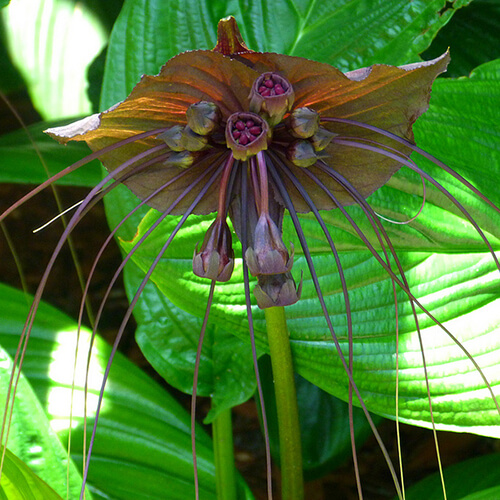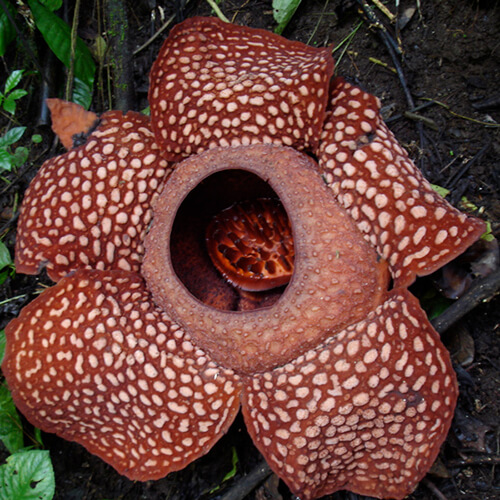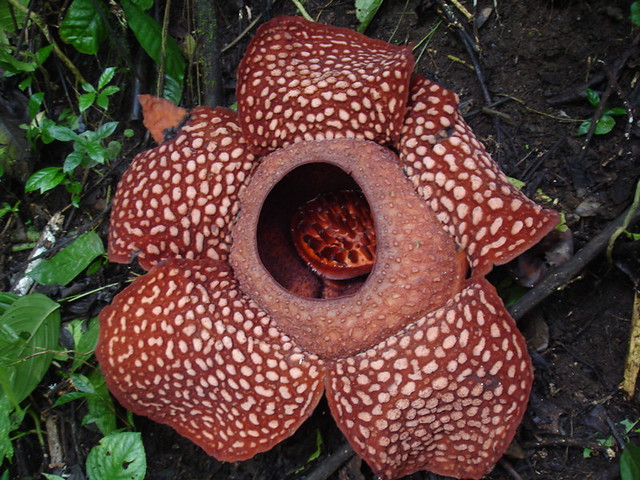Beauty is in the eye of the beholder, but you may be hard pressed to find a beholder who thinks these blooms are beautiful in any conventional sense of the word. Here are 6 fascinating flowers–or potential ‘Stranger Things’ portals?–you might not want to include in your next bouquet.
Black Bat Flower

The black bat flower (Tacca chantrieri) looks exactly how it sounds. The way these flower’s black petals spread – up to a foot long – is reminiscent of their nocturnal namesake. Several long, thin leaves, also known as bracts, spring from the center of the flower, almost looking like black and maroon whiskers. The flower’s unique, if unsettling appearance, has earned it nicknames including cat’s whiskers and devil’s tongue. The plant can grow to be nearly three feet tall and bear up to 25 flowers. The black bat flower’s stem and leaves are thick and green with a smooth texture. You can find this plant thriving in the tropical forests of Southeast Asia.
Corpse Flower
The corpse flower (Amorphophallus titanum) earns its name from the stench emitted by its bloom. While unpleasant to the human nose, the smell of decaying meat is actually advantageous to the plant. The odor will attract the types of carnivorous insects that serve as the plant’s pollinators. The flower has green petals with a deep red color on the inside. Emerging from the center of these petals is a fleshy stalk, which is actually covered in small flowers. The corpse flower may have an unattractive olfactory presence, but its rarity makes it quite popular. The plant’s flower only blooms for a short time once every two to three years or even once every seven to 10 years. When the pungent plant does flower, it draws a crowd. Just this spring and summer, people flocked to see in bloom corpse flowers in Colorado, Florida, Illinois, Indiana, Missouri, New York and Washington, D.C. Perhaps even more interesting than the stench is this year’s oddly in sync schedule for the blooming flowers.
Cobra Lily
If you’ve ever harbored a vague distrust or outright fear of snakes, this flower is sure to top your list of plants to avoid. The cobra lily (Darlingtonia californica), a carnivorous plant, bears a striking resemblance to a hooded cobra. The plant’s appendages – coming in a variety of colors including purple – look much like fangs or a forked tongue, completing the picture. Though the cobra plant cannot bite an unwitting human, its hooded pitcher is the perfect trap for insects. After becoming trapped, prey will eventually fall to the bottom of the plant’s pitcher and to be broken down for the plant’s use with the help of bacteria. The cobra lily, also known as the California pitcher plant and cobra plant, can grow from 16 inches to over two feet tall. As its scientific name suggests, the cobra lily is native to California and the southern part of Oregon.
Rafflesia
Rafflesia, a genus representing 28 different species, is unique in the plant world. The bloom consists solely of a large flower and nothing else, no stem, roots or leaves. Rafflesia, aptly called the monster flower genus, can reach a weight of 24 pounds and a length of a meter. The plant has five thick “petals” that come in shades of red or purplish brown and gives off the smell of carrion. The genus Rafflesia includes the evocatively named stinking corpse lily (R. arnoldii), the single largest flower in the world. Like the corpse flower (Amorphophallus titanum), Rafflesia‘s distinctive odor attracts insects not for consumption, but likely for pollination purposes. The genus of enormous flowers is a parasitic group, gleaning nutrition from the roots of other plants.
Tropical Pitcher Plant
Tropical pitcher plants, or genus Nepenthes, are another carnivorous addition to the list. The genus includes approximately 140 species, each with the signature pitcher-shaped trap that lures insects and other small prey. The soon-to-be meals are attracted to the trap by sweet nectar secreted by the tropical pitcher plant. Once landing, the prey will slip down the pitcher’s throat into a pool filled with digestive enzymes. These flowers, sometimes called monkey cups, are typically found across Southeast Asia, Australia and Madagascar. Unlike most flowers, the tropical pitcher plant has no petals. Instead, the plant has a long climbing stem, which culminates in its sticky trap.
Welwitschia
Welwitschia (W. mirabilis) doesn’t resemble a plant so much as some sort of strange, bedraggled sea creature left out to dry. The plant has a root system, stem and two leathery leaves. The leaves stay with the plant for its entire life, often becoming torn and well worn. The remarkable thing about welwitschia is just how long its life can last. These plants can live up to 1,500 years, unsurprisingly giving it the moniker of “living fossil.” The plant’s different sexes produce different colored flowering cones. Males bear a pink cone, while females have blue-green cones. Welwitschia lives in Africa’s Namib Desert.
-Carrie Pallardy



